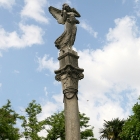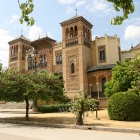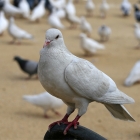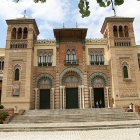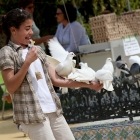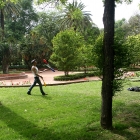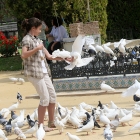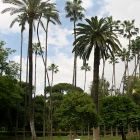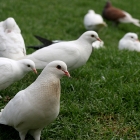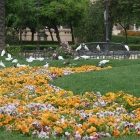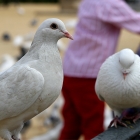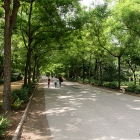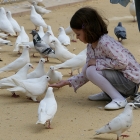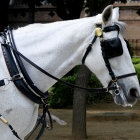White doves in Maria Luisa Park, a place where the Arab gardens were brought back to life by Forestier
It’s hard to chose the most pleasant place in a town so lovely as Seville, but the Park Maria Luisa definitely competes with the most famous civic squares and cathedrals due to its tranquility and harmony. And it’s not all about nature in this park, redesigned for the Ibero-American Exhibition in 1929.
There are several fine buildings inside the park. One is the Museum of Arts and Traditions (Museo de Artes y Costumbres Populares, Sevilla), where you can see collections of costumes and folkloric traditions of Spain and Andalusia in particular. It is a very nice building with apparent brick facade and decorations specific to a revival or Mudejar, the style created by the fusion of the lavish Arab architecture with the traditional Christian taste. The term Mudejar probably comes from Arabic and means “domesticated”, so it’s Moorish but in what the locals considered the “reasonable” lines.
Another representative building is that found in Plaza de Espana, which today hosts the Archeology Museum.
The gardens were designed by Jean Claude Nicolas Forestier, a renowned French architect who worked at reshaping Paris together with his masters – Georges Eugene Haussmann and Jean-Charles Alphand – or at embellishing other major cities like Buenos Aires in Argentina and Havana in Cuba. The project of redrawing Sultan’s Garden in Casablanca, Maroc, a decade prior to this Spanish work was a chance for Forestier to meet his vocation.
Forestier believed in the functionality of the public space, in accordance with the ideas of Le Corbusier, and was in his heart a botanist passionate about every specie of plant. In the northern part of Africa, Forestier met with the Arab tradition of private gardening, with their green labyrinth, orange orchards and majestic palm trees. It was a luxury that was once reserved only to very few, but that could now be used for the urban community. And in Andalusia, the southern Spain, the examples of complicated gardens with artificial rivers and cascades were everywhere, from Alhambra in Granada, to the neighboring Alcazar, right here in Seville.
Nicolas Forestier created a vast park in Seville, fully making use of the Mediterranean vegetation, with orange and palm trees, pines that shadow the geometric alleys, but also with floral arrangements that the French had experimented with.
And the beauty of nature is enhanced by the animals that give life to Maria Luisa Park: the wild humming birds, the athletic horses that pull the carriages and most of all, the white pigeons. The doves are very friendly with humans and barely wait to be fed by tourists on whose arms they often venture.
The park is named after Infanta Maria Luisa Fernanda, Duchess of Montpensier, who donated the land for the park at the end of the 19th century. Maria Luisa was the young daughter of king Ferdinand VII of Spain.
- Home Page
start page - Architecture
landmark buildings - Sacred architecture
places of worship - Nature
landscape photography - Concert
performing artists - Christmas
Santa Claus pictures
- Jooble
jobs for photographers - Escape
an out of control blog - Merry Christmas
The best organizer of Christmas parties - Astro photo
Eclipse hunting and astrological photography

